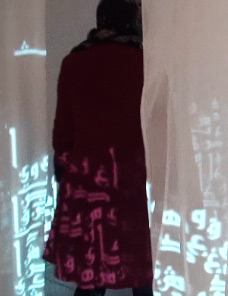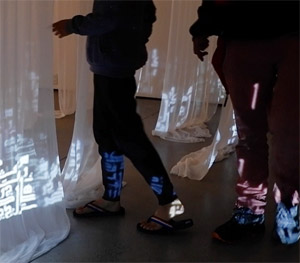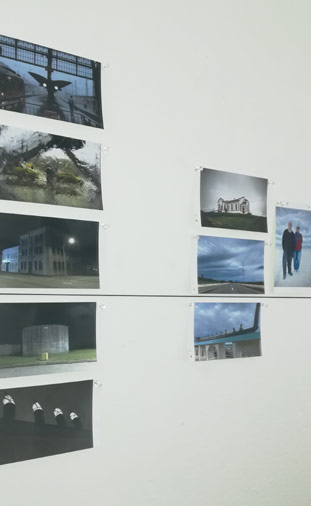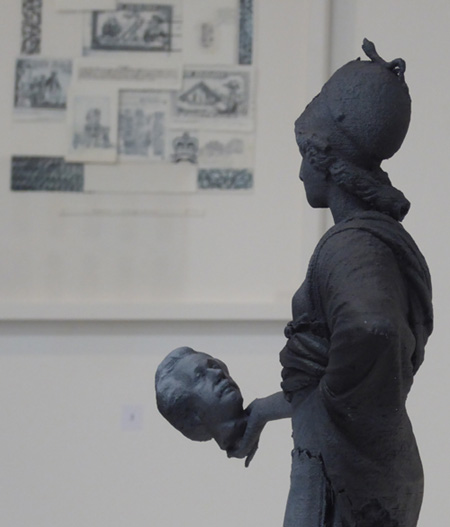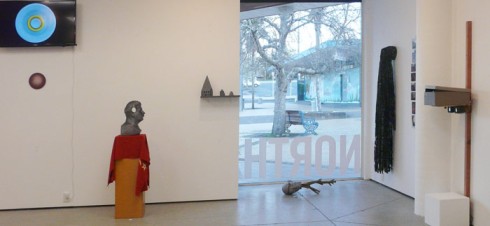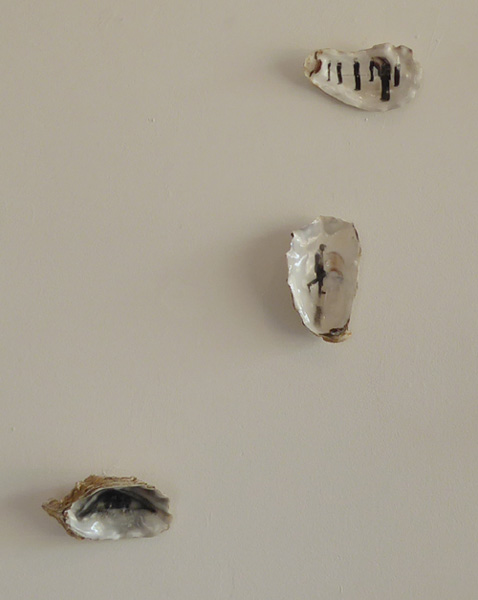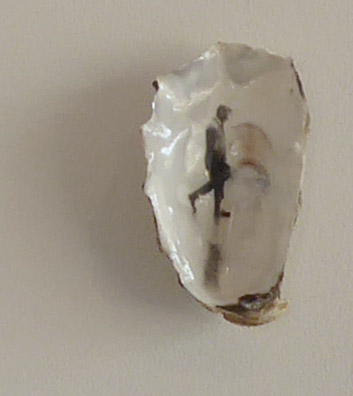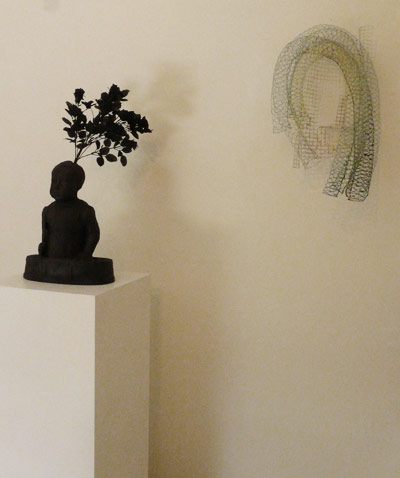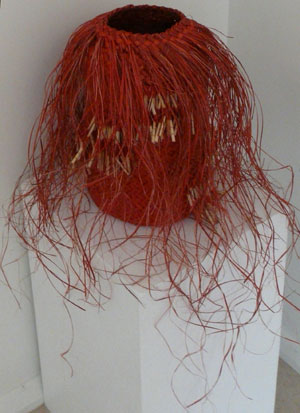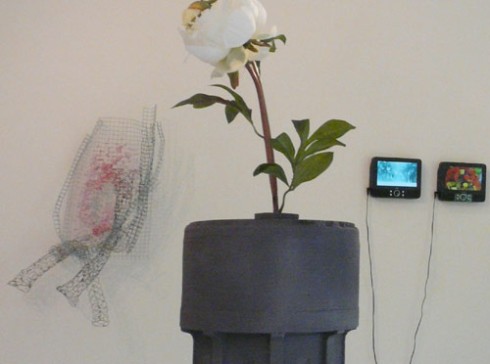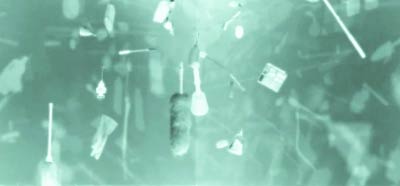in countries more stricken by COVID-19
Aodhán Floyd | April Shin | Ashleigh Taupaki | Bev Goodwin | Brenda Liddiard
Cathy Carter | Chiara Rubino | Emma Papadopoulos | Jessy Rahman | Jumaadi
Lipika Sen | Lissy and Rudi Robinson-Cole | Lloyd Lawrence | Michelle Mayn
Naomi Roche | Narjis Mirza | Martin Wohlwend | Masud Olufani
Nawruz Paguidopon | Prabhjyot Majithia | Phil Dadson
Pietertje van Splunter Robert Hamilton | Sen McGlinn | Shaeron Caton Rose
Sonja van Kerkhoff | Ursula Christel | Xiaojie Zheng | Yllwbro

Detail – Metamorfosi, 2021, Chiara Rubino (Matera, Italy) and Cathy Carter (Auckland, NZ)
Archival pigment ink photographic print on Hahnemuhle photo rag 306gsm. 140 x 90 cm.
Two more works in the main gallery. More photos on artsdiary.co.nz
Left of doorway: Planetscape by Lloyd Lawrence (NYC, USA) and Sonja van Kerkhoff,
The Shaman and the Healing Tree (with mirror) by Jessy Rahman (NL) and Sonja van Kerkhoff.
Metro Manila, photo-print by Nawruz Paguidopon
Above: A Paradox of Place by Sonja van Kerkhoff. Acrylic on wood, 61 x 84 cm. Wood from the Netherlands with a view of Matariki (The Seven Sisters constellation) as above Aotearoa.
Earthscape I, II, III, by Lloyd Lawrence (NYC, USA) with Sonja van Kerkhoff, 3 laser prints on transparency. Limited Edition of 5. Approx 29 x 20 cm. Lloyd emailed photos of his colleges made out of Art Catalogues, giving Sonja freedom to print them in any manner.
Diary of Dust, 2016, Animated, Produced, and Directed by Dave Brown. 2 min 53 sec animation featuring Jumaadi’s, 2014, 7 metre drawing made during a residency at the Halsey Institute of Contemporary Art, College of Charleston School of the Arts, South Carolina, U.S.A. The Halsey Institute commissioned San Francisco-based filmmaker Dave Brown to make this video animation with original gamelan music, composed and performed by Nathan Koc.
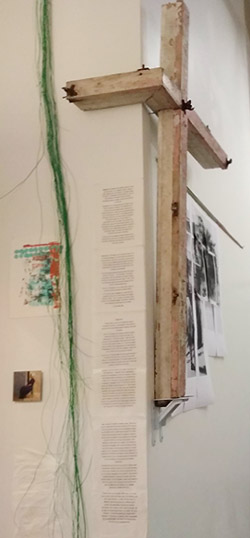
Philoxenia 4, 2021, by Emma Papadopoulos. Acrylic on paper, 24 x 30 cm
Josephine’s Mother by Sonja van Kerkhoff, photo-print, 10 x 10 cm, crushed paper – Naomi Roche.
Sen printed out a drawing onto multiple layers, and assembled these under a wooden construction. Drawing by Aodhán Floyd of his father standing in the UN buffer zone in Cyprus.
“‘Deposition’ is an indirect portrait of my father, Anton Floyd, a poet and translator. He is standing in his home city, at a barricaded border crossing on the southern side of the ‘Green Line’ that divides the island and runs through the capital.” – Aodhán Floyd, Cork, Ireland
Texts incorporate Emma’s thoughts (her father is a Cypriot), Aodhan’s reflections, Sonja’s 2009 performance across the Nicosia Green Line, and Sen’s reflections.
The Green Line, 2021 by Bev Goodwin. Recycled telephone wire.
Philoxenia, 2021. Arrangements by Emma Papadopoulos (Greece), Naomi Roche and Sonja van Kerkhoff
“Philoxenia of Greek origin literally means ‘friend to a stranger’. Philoxenia pertains to taking care of, looking after, being hospitable. My tavern chairs, my cultural reference to Greek hospitality, are currently empty due to lockdown.”
– Emma Papadopoulos, Athens, Greece.

Detail of the main gallery – works by Aodhán Floyd (Cork, Ireland), April Shin, Brenda Liddiard, Jumaadi (Australia/Indonesia), Emma Papadopoulos (greece), Masud Olufani (USA) and Ursula Christel, Nawruz Paguidopon (The Philippines), Phil Dadson, Pietertje van Splunter (The Netherlands), Shaeron Caton Rose (UK), and Xiaojie Zheng (SF, USA/Wenzhou, China)

selfies from the other side – Aodhán Floyd, Chiara Rubino, Emma Papadopoulos, Jessy Rahman, Jumaadi, Lloyd Lawrence, Martin Wohlwend, Masud Olufani, Nawruz Paguidopon, Pietertje van Splunter, Robert Hamilton, Shaeron Caton Rose and Xiaojie Zheng
Details about each selfie is here: sonjavank.com/takecare/
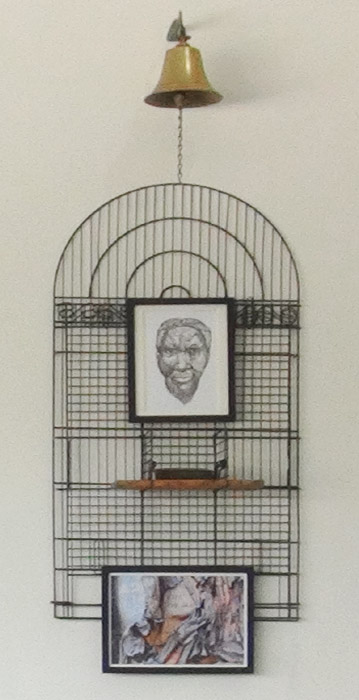
The Wealth of the Nation, 2021, by Masud Olufani (Atalant, USA)
and Ursula Christel (Warkworth, NZ).
4-minute video, with accompanying text and a wall installation in the main gallery. Repurposed metal birdcage and brass bell, 2 framed digital prints, NZ native timber, cut and burnt copy of Adam Smith’s The Wealth of Nations (first published in 1776), twine, shellac. POA. The installation is a reinterpretation of The Wealth of the Nation (2019) by Masud Olufani; re-framed in New Zealand by Ursula Christel, in consultation with Masud.

Global Pandemic, 2021, by Robert Hamilton and Bev Goodwin 1 minute, 35 second video. Lightbox by Cathy Carter. Aus dem Gleichgewicht (Out of Balance), 2021, by Martin R. Wohlwend (Triesen, Liechtenstein) and Naomi Roche (Hamilton, NZ). Mats and carpets from artists’ homes. Windowsill sculptures: Kete I + Kete II by Ashleigh Taupaki (Auckland, NZ) and Shaeron Caton Rose (North Yorkshire, U.K). Mind That Māori suspended crochet vest by Lissy & Rudi Robinson. They are Minding their own Business, silkscreen on cloth by Sonja van Kerkhoff. Toro Mai Tō Ringa / Reach Out Your Hand, animation + wall sculpture by Nawruz Bernado Paguidopon (Manila, The Philippines) and Lissy & Rudi Robinson-Cole (Auckland, NZ).
The Wealth of the Nation, 2021, by Masud Olufani and Ursula Christel.

Detail: Rigenerazione by Chiara Rubino (Matera, Italy) and Cathy Carter (Auckland). Global Pandemic, 2021, by Robert Hamilton and Bev Goodwin 1 minute, 35 second video. Lightbox by Cathy Carter. Aus dem Gleichgewicht (Out of Balance) by Martin R. Wohlwend and Naomi Roche. Mats and carpets. Windowsill sculptures: Kete I + Kete II by Ashleigh Taupaki and Shaeron Caton Rose.

Transformazione, 2021, by Chiara Rubino (Italy) and Cathy Carter (Auckland). Archival pigment ink photographic print on Hahnemuhle photo rag 306gsm. 140cm x 90cm. Rigenerazione by Chiara Rubino and Cathy Carter. Global Pandemic by Robert Hamilton and Bev Goodwin. Lightbox by Cathy Carter. Aus dem Gleichgewicht (Out of Balance) by Martin R. Wohlwend and Naomi Roche. Windowsill: Kete I + Kete II by Ashleigh Taupaki and Shaeron Caton Rose.

Colour wheel, 2021, by Pietertje van Splunter. Acrylic paint on wood. Te Ara ki Rangihoua: The Way to Rangihoua (2018), by Yllwbro (NZ) and participating artists, five scallop shells. Care of the artists and Mokopopaki. Transformazione by Chiara Rubino and Cathy Carter.
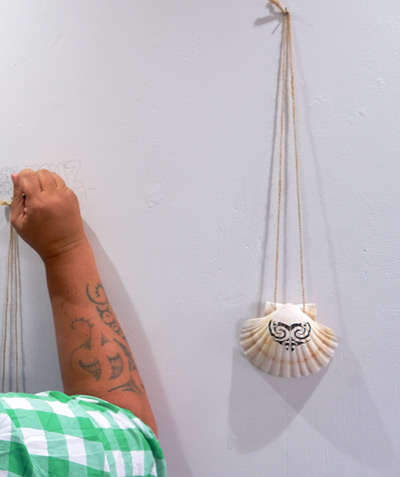
Lissy writes Nawruz’s name. Te Ara ki Rangihoua: The Way to Rangihoua (2018) by Yllwbro (NZ) and participating artists.
– a scallop shell for each person, hung at their heart-height. With accompanying text elsewhere in the gallery. Lloyd Lawrence, NYC, U.S.A (153 cm), Shaeron Caton Rose, North Yorkshire, U.K (120 cm), Nawruz Paguidopon, Manila, The Philippines (127 cm), Xiaojie Zheng, San Francisco U.S.A. / Wenzhou, China (120 cm),
Robert Hamilton, Ontario, Canada, (150 cm).
Scallop shells, brown string, moko adhesive. Care of the artists and Mokopōpaki.

E-Motion (Kinetic series #1), 2021 by Phil Dadson, a response to Colour wheel, 2021, by Pietertje van Splunter (The Hague, The Netherlands, acrylic on wood -tree ring).
Acrylic on wood, motor/Arduino module, steel stand. The E-motion series is a spin-off from the June Music concept (2019), where ratios of frequency, rhythm and colour are conjured up from imagined lines of sonic shape and form in the material world. Like a breathing mandala, this first of the E–Motion series animates this idea from the 3rd to the 4th dimension.
(With thanks to James Charlton for motor/Arduino assistance).
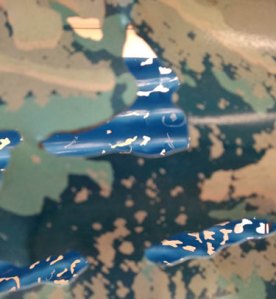
Detail of Huroof e Muqataat (The Disconnected Letters), chalk Arabic letters by Sen McGlinn on the inside of
Wake, corrugated iron water tank, by Jeff Thomson
Salama Moata McNamara for her help in the exhibition.
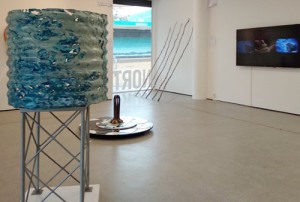
Click for a larger view of this image.
Foreground: Wake, silkscreened corrugated iron water tank, by Jeff Thomson; New Space / Takawaenga, circular floorpiece, by Ursula Christel; Talking Sticks by Carolyn Lye;
Conference of Stones,
video and soundscape by Phil Dadson
Two texts in Arabic high on the walls read: ﯸ ﯷ (Until you have asked permission) and above the video: ةحال (The Stones)
Some of the works by 24 artists (listed here) were aesthetic responses to the 2019 Christchurch mosque massacres while others were re-contextualizations, or responses to the Qur’an and the diverse cultures and histories of Islamic worlds. A general aim here was to include Islam in a New Zealand aesthetic landscape, and to see what changes.
I will focus here on nine works in the show, and write separate blogs on the other works in the three gallery spaces.
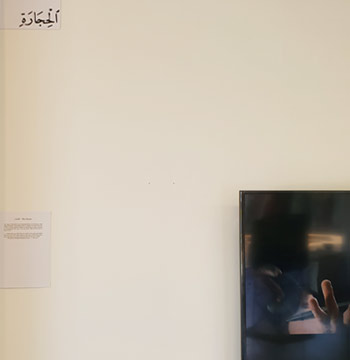
The Arabic text above means “The Stones”
below detail of Conference of Stones,
video and soundscape by Phil Dadson
Photo: Ursula Christel
Five texts in Arabic were positioned high on the walls around the front gallery to re-contextualize the adjacent artworks. One of these texts “Hijārat” (the stones), near Phil Dadson’s video and soundpiece, “Conference of Stones” was accompanied by two excerpts from the Qur’an: “There is not an animal on earth, no bird flying on wings, but they are communities like you.” (6:38) Even the stones “fall down for fear of God” (2:74). Both texts, and the video and soundscape, bring focus to the natural world as a source for understanding. The Qur’an refers to communities in the animal world, while the reference to stones could be read as either a metaphor for the hardened self (“your hearts were hardened”, 2:74) or as the omnipotence of Allah because even stones are moved.
When I first watched the video it reminded me of the poem “The conference of the birds,” by Persian Sufi poet Farid ud-Din Attar (c. 1145 – c. 1221) where diverse birds, each with a differing human-like weakness, seek to find a leader. After tests and journeys, thirty birds survive and discover that collectively their diverse traits form something greater.

Click for a larger view.
Still: Conference of Stones, 2013, video and soundscape,
by Phil Dadson.
Filmed in HD 1920 x 1080 digital moving image, stereo recorded with Sennheisser microphones.
Credits:
Performed by Phil Dadson
Camera by Bruce Foster
Sound recorded by John Kim
Digital video/audio by Phil Dadson
Produced with the support of Pew Charitable Trust, CNZ Arts Council of New Zealand, Colab Creative Technologies,.
Watch an exceprt of this 3 screen video on vimeo.
The ‘conference’ in the poem takes the form of journeys and challenges penned in allegory with multiple meanings, while in the video the ‘conference’ is the distinctive voices of handheld tapping stones collected by the artist from locations in diverse countries. The sonics of these stones were intended to resonate throughout the gallery like ripples and then beyond into the middle gallery to merge with the more abstracted and melodic soundscape from the third gallery, by Los Angeles based omposer and musician, Jessika Kenney.
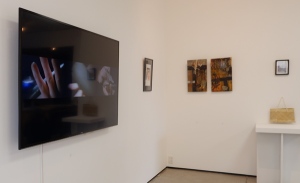
Click for a larger view.
Conference of Stones, video and soundscape by Phil Dadson, Peace Flight, (far wall) Passion I and Passion III by Brenda Liddiard; A Matter of Faith, by Fiona Lee Graham; Kete Muka Tuatahi by Christina Hurihia Wirihana.
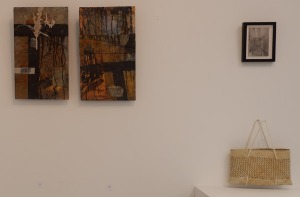
Click for a larger view.
Passion I and Passion III, 2010, Mixed media & collage on board, by Brenda Liddiard;
A Matter of Faith, 2020, monoprint, ink on paper, 150 x 100mm, by Fiona Lee Graham; Kete Muka Tuatahi by Christina Hurihia Wirihana.
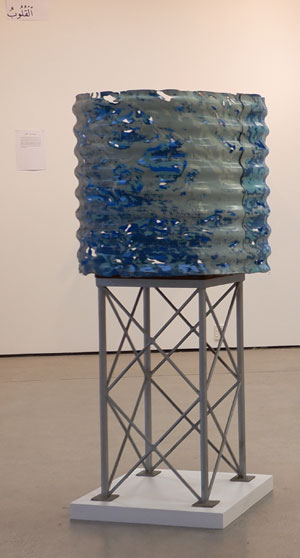
Wake, silkscreened corrugated iron water tank,
by Jeff Thomson
The Arabic text on the wall beyond reads ‘The Heart’
Across from the video stands Wake, a customized mini-watertank by Jeff Thomson. The form speaks of containment, but on closer inspection it is about the impossibility of this. Numerous holes perforate the sides and bottom of the tank. These are not immediately visible because they match the silkscreened watery patterns and are therefore masked. These patterns are the ‘wake’ in the title: signs that something no longer present has passed by.
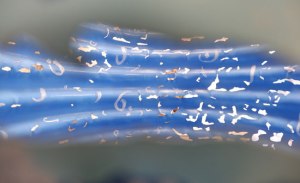
Click for a larger view.
Detail of Huroof e Muqataat (The Disconnected Letters),
chalk Arabic letters by Sen McGlinn inside
Jeff Thomson’s water tank sculpture.
Inside this water tank are chalked floating Arabic letters, Huroof e Muqataat (The Disconnected Letters) by Sen McGlinn. This refers to the letter sequences called “Huroof e Muqataat” that begin 29 of the 114 chapters of the Qur’an. When reciting these Surahs (Chapters), these letters are pronounced as single letters, not formed into words. They are not semantic units of meaning but serve as sound – or as form if the person is reading – as a mystical or mysterious element to this Holy Book. McGlinn chose these letters to recontextualize this sculpture as a visualization for a sea of meaning that cannot be grasped: the ineffable. The absurdity of water containing water becomes a metaphor for the enigmatic wake left by a presence.
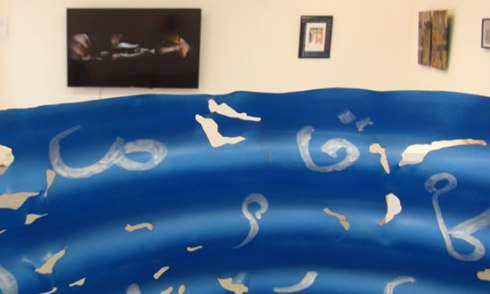
Detail of Huroof e Muqataat (The Disconnected Letters), chalk Arabic letters by Sen McGlinn
and Wake, corrugated iron water tank, by Jeff Thomson. Background: Conference of Stones, video and soundscape by Phil Dadson, Peace Flight, Passion I and Passion III by Brenda Liddiard;
A Matter of Faith, by Fiona Lee Graham;
The end gallery installation, Haykal Al Noor (Bodies of Light) by Narjis Mirza consists of projections of letters falling down twelve translucent columns of silk. Akin to the “Huroof e Muqataat” of the Qur’an, these letters or letter compositions do not form words. Each letter or combination becomes visible as it strikes the top folds of fabric and then descends to rest in a composition of other letters in the ancient Kufic font. This font is still used for permanent commemorative plaques and hence is generally associated with stability, the semantic and the architectural. Mirza’s use of this font as illuminated descending non-semantic form changes this context to the ephemeral, physical and conceptual. These letter-bodies are not prescriptive but are signs of the abstracted mystical or otherworldly.
Mirza is enrolled in a PhD at AUT (Auckland University of Technology) and is influenced by the 20th century Huroofiya Art Movement where Arabic calligraphy is deconstructed and abstracted from its more literal usage. Some schools within this movement also focus on symbolic meanings in the cosmos for these letters. Her interactive installations are practice-based research into philosophical notions of light, language and art and this installation is part of her research. The human presence is a vital part of this installation: the viewer is invited to move between the diaphanous columns.
Projections of these illuminated letters are intended to fall on the visitors’ bodies as well as onto the columns of delicate fabric so that the word ‘Haykal’ (Bodies) in title references both the Arabic letters and the presence of the viewer, whether as the body-self inside the installation, or as observer watching others as forms, continually shaping these projections. The bodies of the visitors complete the intention of this site-specific installation which here, exists in parallel with the soundpiece, Pamor performed and composed by Jessika Kenney. ‘Pamor’ refers to metallurgical patterns in ritual weapons. The sung syllables are abstracted from a Javanese prayer attributed to Sunan Kalijaga, one of the nine Sufis who brought Islam to Java over five centuries ago.
A list of the 24 artists in this exhibition | Next blog on this exhibition >>
About these 8 artists
Brenda Liddiard is a visual artist and singer songwriter/musician based in Auckland, Aotearoa | New Zealand. She has been exhibiting her paintings since 2008. brendaliddiard.co.nz, and is co-founder of the fundraising art organisation, Art for Change (www.artforchange.net).
Christina Hurihia Wirihana, based in the Bay of Plenty, Aotearoa | New Zealand, is a weaver of Te Arawa, Ngāti Maniapoto, Ngāti Pikiao, Ngāti Rangiunora, Ngāti Raukawa, Tainui descent. Wirihana is the Chairperson of Te Roopu Raranga Whatu o Aotearoa (National Collective of Māori Weavers in New Zealand). In 2014 this collective of weavers exhibited 49 tukutuku panels in Kāhui Raranga: The Art of Tukutuku at Museum of New Zealand Te Papa Tongarewa. These panels are to be installed early 2015 at the Headquarters of the United Nations in New York. In 2003 Wirihana received Te Tohu Toi Kē from Te Waka Toi Creative New Zealand for making a positive development within Māori arts. See: wikipedia.org/wiki/Christina_Wirihana
Fiona Lee Graham, based in Auckland, completed a Bachelor Degree in Design and Visual Art, majoring in Painting, at the Unitec, Auckland, in 2010. See: thegreyplace.nz/artists/fiona-lee-graham
Jessika Kenney, based in Los Angeles, U.S.A. is an experimental vocalist, composer, and teacher. She is most known for her performances of Indonesian vocal music (sindhenan), and Persian vocal music (radifs), as well as for her compositions drawing on elements of both. See her discography – jessikakenney.com
Jeff Thomson based in Helensville, Aotearoa / New Zealand is known for his sculptures and site-specific installations using corrugated iron as his main medium. His sculptures range from the well-crafted and iconic, such as his suite of New Zealand native birds, to the conceptual, such as his cut and corrugated ironing boards, or the add-ons he created for the roofs of houses scattered throughout the city of Whanganui, to the quirky, such as his water tanks, some filled with water, peep holes and motors. jeffthomson.co.nz
Narjis Mirza, born in Pakistan and now based in Sydney, Australia, is an installation artist. Her research examines the confluence of eastern philosophy with virtual reality, highlighting the transcendent philosophy of Persian philosopher Mulla Sadra (1571–1636). She completed her Master’s degree in Media and Design from Bilkent University Ankara, Turkey, after a Bachelor’s in Fine Arts with distinction at the National College of Arts in Pakistan. She is currently undertaking a PhD at the Auckland University of Technology. narjismirza.com
Phil Dadson, based in Auckland, Aotearoa / New Zealand, is a video & sound artist with a transdisciplinary practice including building and performing with experimental musical instruments, sound sculptures, digital media, music compositions, graphic scores and drawings. Moving image and foregrounding sound has been a feature of his practice since the early 70s, referencing the body, land, nature, and the human condition. He also founded the music/performance group, From Scratch (1974 – 2004). Awards & residencies include: US Fulbright 1991, NZ Arts Foundation Artist Laureate 2001, Antarctic Artist Fellowship 2003, ONZM 2005, Sankriti residency (India 2007), Artist Cinema commission 2010, Wallace Arts Trust Jury award 2011. thearts.co.nz/artists/phil-dadson
Sen McGlinn, born in Christchurch, Aotearoa / New Zealand has recently returned to live in the Far North after living in the Netherlands for almost 30 years. He has a Master’s in Islamic Studies from the University of Leiden, The Netherlands, where he is working on a PhD. He has authored and co-authored a number of books in Persian Literature & Iranian Studies. He has exhibited in sculpture parks and galleries since the early 90s. sculpturebysen.wordpress.com
]]>Geoff Wilson Gallery, NorthTec Campus, Whangārei, Aotearoa
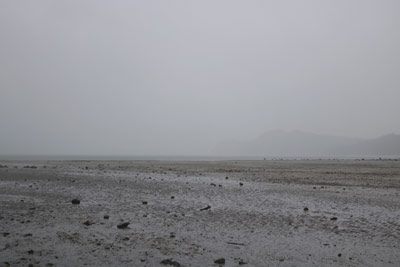
Ghosts photographic print by Ashleigh Taupaki. 42.0 x 59.4 cm
I te huringa kōmuri, e haramā te whenua i te kēhua
On looking back, the land was covered white with ghosts
Hauraki proverb
Over 50 works in diverse media on themes of proverbs and sayings by artists based in Aotearoa and beyond, curated by Sonja van Kerkhoff with 3rd year NorthTec year students.
Artists
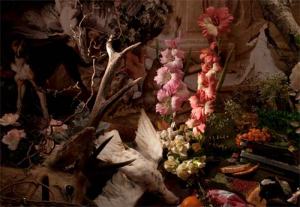
Animal Picnic, Archival Lambda print, 1 out of edition of 3
by Andrea Gardner. 82 x 57 cm
(click for a larger view)
Andrea Gardner, Whanganui
Ashleigh Taupaki, Auckland
Brenda Liddiard, Auckland
Brit Bunkley, Whanganui
Carolyn Lye,
Karetu, The Far North
Catrina Sutter,
Russell / Kororāreka
Chiara Rubino,
Matera, Italy
Cle Tukuitonga, Otangaroa, The Far North
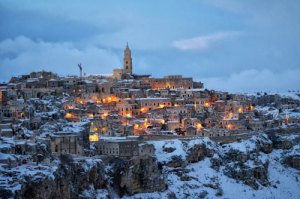
Chiara Rubino, photographic print, 28 x 21 cm
Buona e’ la neve che a suo tempo viene
Good is the snow that comes in its time
Chiara Rubino photographs her home city, Matera, a UNESCO heritage city in southern Italy.
London, UK
Giacomo Silvano,
Irsina, Italy
Hilda Simetin, Auckland
Jacqueline Wassen, Maastricht,
The Netherlands
Jamie Larnach, Auckland
Jarred Taylor + others, Whangārei
Jeff Thomson, Helensville
Joas Nebe, Germany
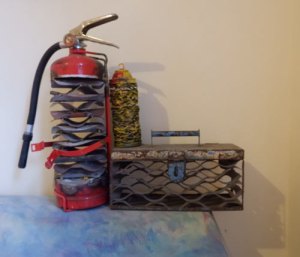
Jeff Thomson, 3 piece assemblage
“There’s No Iron So Hard That Rust Won’t Fret It;
and There’s No Cloth So Fine That Moths Won’t Eat It.” Scottish Proverb
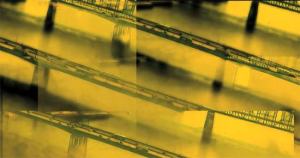
Joas Nebe, still, The Shareholder´s Room, video, 3 min 45 sec
Man steigt nicht zweimal in denselben Fluß
You Cannot Step Into the Same River Twice
Heraclitus (c. 535 – c. 475 BC, Greece)
John Mulholland, Warkworth
Maartje Zandboer, The Hague,
The Netherlands
Naomi Roche, Waikato
Lipika Sen & Prabhjyot Majithia, Auckland
Peter Scott, Kerikeri
Piet Nieuwland, Whangārei
Robert Brown, Whangaparaoa
Sam Melser, Auckland
Sonja van Kerkhoff, Kawakawa
Tash Nikora, Whangārei
Tracy Singer, Auckland
Ursula Christel (Mokopōpaki), Warkworth
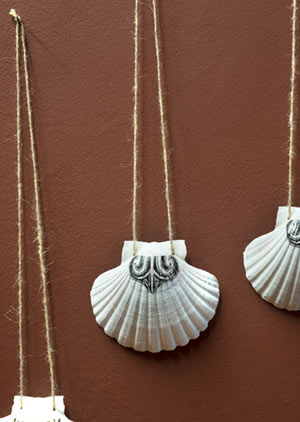
Yllwbro Te Ara ki Rangihoua: The Way to Rangihoua, 2018 Scallop shells, brown string, moko adhesive.
Courtesy the artists and Mokopōpaki, Auckland
Geoff Wilson Gallery, NorthTec, Gate 3, 51 Raumanga Valley Road, Whangarei
Opening 4-7p.m., 21 Feb 2020
open: 12 – 4 p.m. Wednesdays – Fridays,
and by appointment.
facebook event page for this exhibition
]]>The self-deprecating title, also a witty allusion to pop art (Roy Lichtenstein’s paintings of cartoons with speech bubbles were often onomatopoeiatic and pop art itself re-presented the ordinary and contemporary). The exhibition was a photographic project that translated the snap-shotted individual instant into the multi-medial.
It was also a participatory project: anyone with a smart phone and $2 was invited to add one of their snaps to the walls. A horizon line served as a visual guide but also added a level of complexity to the experience of Snap, Crackle Pop-up. Images above, below or across the line invited the viewer to read meanings into the placement and juxtapositionings – akin to how (despite our belief in our individualisms) each of us, is affected by our society.
The ShutterRoom is hardly a pop-up gallery having a stable following for over five years in its central Whangarei space directly across from the city public library. This proximity was part of the aesthetic experience created by The Shutter Room Collective curators, Heath, Leigh & Ken.
The first instruction I was given was to take 30-odd steps towards the library to use the wifi access there to download the app required to print out my snapshot. Back in the gallery, the snapshot was printed and I was given pins to place it anywhere on the walls. Feeling rebellious, I pinned my image across the line then I counted only one cat and several baby photos in the 50 or more images. The open curation approach had an element of risk, especially where a broad public could easily walk in, but the eye height line appears to have encouraged a self displine in regards to the content and thoughtfulness in the total composition. ]]>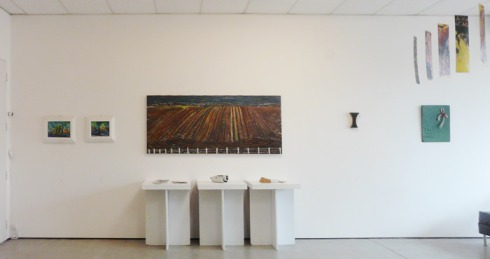
Left to Right: “HearSay,” soundpiece, 2018, recording of a generated audio work, by Jonathan Reus.
Two paintings by Roger Morris. “Trope,” 2018, oil on canvas, 190 x 75 cm by Raewyn Turner and ceramic works by Jess Paraone. Two small works by Sonja van Kerkhoff. “Pandora’s Box” 5 piece suspended double side painting by Alexis Hunter.
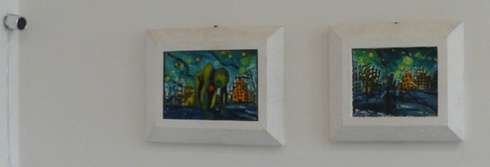
Left to Right: “HearSay,” soundpiece, 2018, recording of a generated audio work, by Jonathan Reus.
“Enduring Freedom” and “‘Axis’ ONE” Oils on board by Roger Morris.
“HearSay,” was created by an algorithm which recombined recordings of news broadcasts from CNN, MSNBC and the BBC of an underground slave trade emerging in Libya as reported by CNN in October 2017. The story of the slave trade in Libya was reported through rumors and collections of stories by migrants stranded in local detention camps. This work highlights the problem of news organisations presenting images of truth when these are based on fragmented and subjective testimony.
This is one of several algorithmically generated sound works by Jonathan Reus, which explore the aesthetic elements of news broadcasts, by contrasting the authoritative voices of news reporters to witnesses, foley sounds, and background music used to enhance drama in the macro and micro sonic. A first sketch of this work was created during the Transmarcations work session in Brussels, 2017 organized by http://constantvzw.org

“Binary investigations,” 2 piece glazed ceramic, “Binary investigations,” glazed ceramic, “Liminal,” ceramic, “Binary with foundation,” partially glazed ceramic by Jess Paraone (Ngāti Kawau, Kaitangata).
The rows of zeros and ones stamped into the slab-like “Binary series” works by Jess Paraone (Ngāti Kawau, Kaitangata) play off against expressionistic abstract colours and glazes. These numbers can be read simultaneously as abstract element and as symbol for the human or mark of the human made machine. The central piece, from the “Liminal” series is a rolled slab of black dyed raku clay and porcelain clay – materials with very different properties. The contrasting materiality (rough vs smooth, brittle vs elastic) and colours invite multiple readings on the theme of oppositions, compatibility, and diversity.
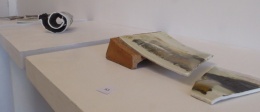
“Liminal,” slip cast porcelain slab + raku clay coloured with black stain, fired to 1260 degrees celcius, “Binary with foundation,” glazed porcelain and brick by Jess Paraone. Click for a larger view.
Gallery 1 | Gallery 2]]>
Jess Paraone (Northland) | Brit Bunkley (Whanganui) | Virginia Guy (Northland) Alexis Hunter (London), Marianne Muggeridge (Taranaki) | Roger Morris (Taranaki) | Raewyn Turner + Brian Harris (Auckland)
Thom Vink | Jonathan Reus | Pietertje van Splunter | Sanne Maes | Channa Boon | Anne Wellmer | Martje Zandboer Sissel Marie Tonn |
Yair Callender | Sonja van Kerkhoff
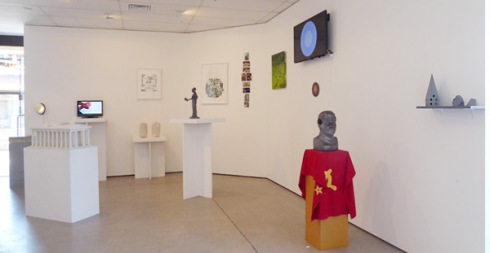
Aesthetic explorations of the individual in society
by
artists from The Hague and Aotearoa | New Zealand.
Photographs: Sen McGlinn.
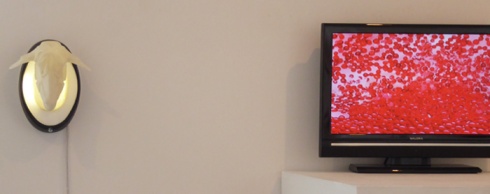
“Hazzard Sheep” by Brit Bunkley (Whanganui),
Still from “Een Rode Citroen” (A red lemon), 9 minute 53 second animation.
Soundtrack Anne Wellmer. Drawings: Geerten Ten Bosch. Animation Harriët van Reek
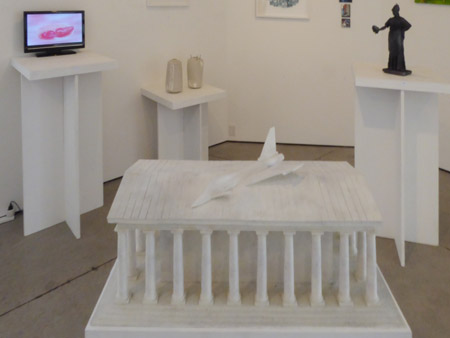
Still from “Een Rode Citroen” (A red lemon) by Anne Wellmer.
Foreground: “Rejoice” and right, “Hamlet”
3D plastic prints by Brit Bunkley.
Ceramic vessels by Jess Paraone (Northland)
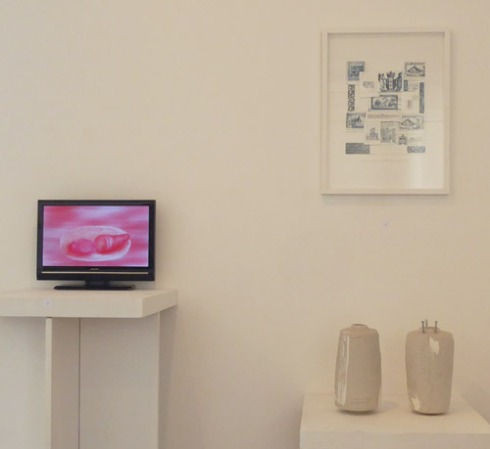
“A Red Lemon” video by Anne Wellmer, “Vessel 1” + “Vessel 2” ceramic with mixed media by Jess Paraone (Northland), Photo intaglio, Emboss, Chine colle, 1/1, by Virginia Guy (Northland)
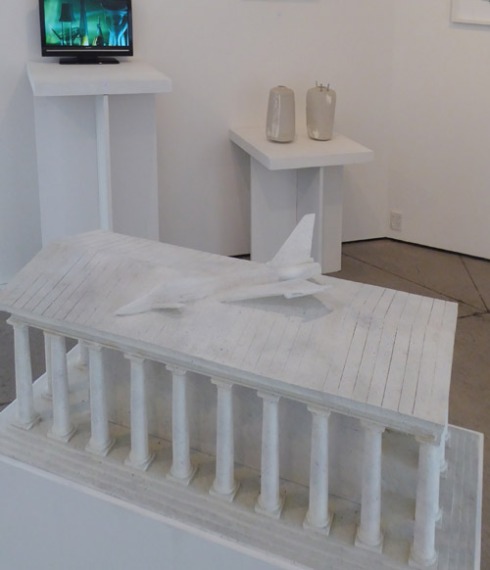
Still: Vox Sanguinis (Voice of the blood), 2015 1′ 52”
Video and soundtrack by Anne Wellmer. Camera: Florian Cramer. Voice: Cora Schmeiser. Music: “O rubor sanguinis” by Hildegard of Bingen. Trumpet: Heimo Wallner. Silent performer and stage design: Geerten Ten Bosch.
“Vessel 1” + “Vessel 2” ceramic with mixed media by Jess Paraone
“Rejoice!” PLA plastic and paint by Brit Bunkley”

“Vessel 1” + “Vessel 2” ceramic, engraved sequences of zeros and ones, and nuts and bolts,
by Jess Paraone (Ngāti Kawau, Kaitangata)

Transfusionen (Transfusions), 2015, video with sound, 2′ 43”
Soundtrack: Anne Wellmer. Hands: Geerten Ten Bosch, Voice: Cora Schmeiser. Music fragment from BLAST (2015) by Lukas Simonis. Text fragment from ‘Della Religione Christiana’ by Marsilio Ficino (1433-1499), first published in Italian in 1568. This German translation was published in ‘Das Blut: Symbolik und Magie’ (2004) by Piero Camporesi. The text tells of how witches used the blood of children to make medicine and the various uses (transfusions or transmutations) of this medicine, including the making of wine.
Two Photographic intaglio and embossed prints by Virginia Guy, Ceramic vessels by Jess Paraone, Nine prints by Sonja van Kerkhoff (The Hague / Northland)
Two sculptures by Brit Bunkley
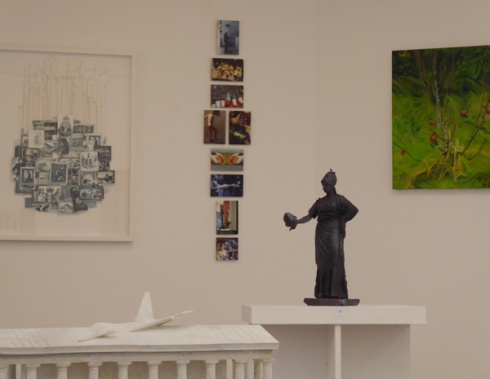
Detail: “Rejoice” 3D plastic print by Brit Bunkley.
“Turangawaewae – Aotearoa – Home,” Photo Intaglio, Emboss, Chine colle, multi-piece etching
by Virginia Guy.
“Child’s Play” photographic prints on dubond by Sonja van Kerkhoff
“Hamlet” 3D plastic print by Brit Bunkley.
“Apple Tree” oil on linen by Marianne Muggeridge (Taranaki).
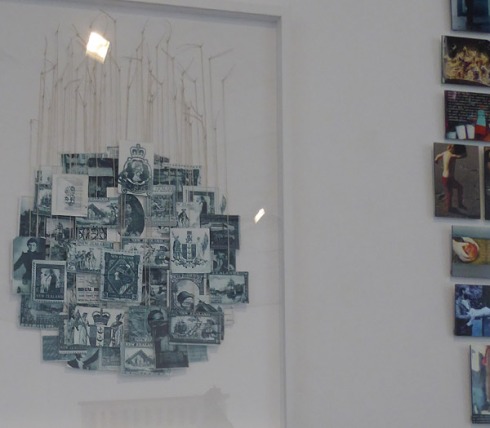
“Turangawaewae – Aotearoa – Home,” Photo Intaglio, Emboss, Chine colle, multi-piece etching by Virginia Guy. “Child’s Play” photographic prints on dubond by Sonja van Kerkhoff
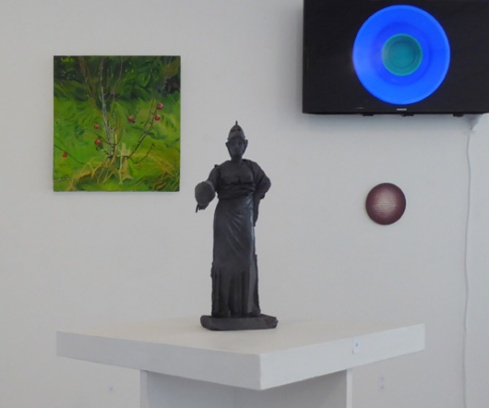
“Apple Tree” oil on linen by Marianne Muggeridge
“Hamlet” 3D plastic print by Brit Bunkley.
“Plastic Play” 3 min stop motion animation by Pietertje van Splunter (The Hague)
“What kind of Idea” print on aluminium by Sonja van Kerkhoff
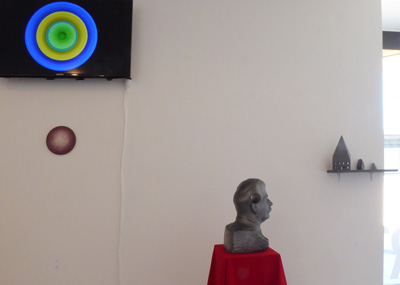
“Plastic Play” by Pietertje van Splunter, “What kind of Idea” by Sonja van Kerkhoff, “Social Realism” by Brit Bunkley, “The Speed of Dark” by Thom Vink

Two sculptures by Brit Bunkley, stop motion animation by Pietertje van Splunter, Architectural models on shelf by Thom Vink, Floor sculpture by Sanne Maes, Two wall works by Sonja van Kerkhoff
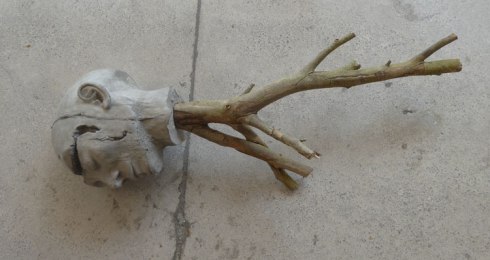
“Metamorphosis IV” Dutch concrete and Taranaki branch, 40 x 100 x 60 cm,
by Sanne Maes (The Hague)
One of a number self-portrait explorations on the inner and outer in relation to the natural world.
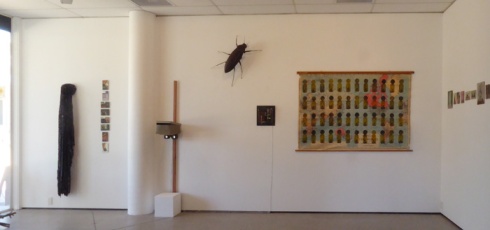
“A Tangled Tale,” batiked cloth strips bearing texts in Dutch, English and Maori, “Child’s Play” photographic prints by Sonja van Kerkhoff
“Take My Shoes” by Raewyn Turner and Brian Harris, shoebox, electronics and video
“Ungeziefer 2” ASB plastic and paint, by Brit Bunkley
“Dark Perfume with Integrated Circuit” by Raewyn Turner and Brian Harris
“MAP” by Roger Morris [ r e m o ] (Taranaki)
Small paintings by Pietertje van Splunter (The Hague)
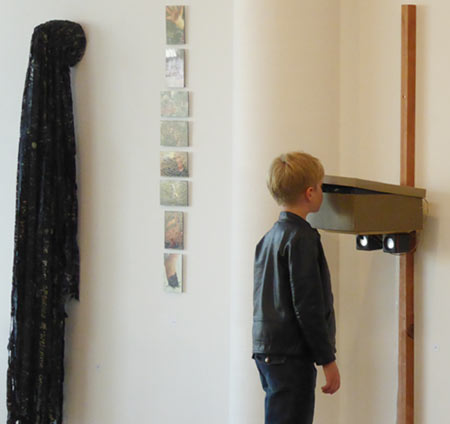
“Take My Shoes” by Raewyn Turner and Brian Harris, shoebox, electronics and video. The voice of a retired police officier plays when someone looks into the box.

Detail of “Take My Shoes” by Raewyn Turner and Brian Harris showing a video, reflections of this in mirrors and figurines.
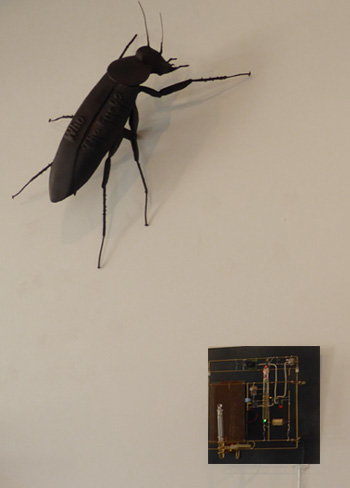
“Ungeziefer 2” ASB plastic and paint, by Brit Bunkley. “Ungeziefer 2” ASB plastic and paint, by Brit Bunkley. Ungeziefer (vermin, pest or unclean) refers to the main character in Kafka’s novel, The Metamorphosis (Die Verwandlung), in which a salesman awakes to find that he has metamorphosed into a monstrous vermin (“ungeheures Ungeziefer”).
“Dark Perfume with Integrated Circuit” by Raewyn Turner and Brian Harris. Perfume with electronics and sensor, Omani Frankincense, costus, cocoa, civet, tea, cepes, heliotrope, pink champaca, black pepper, vetiver, pure alcohol
When the work is approached to sample the sweet perfume sealed in the flask, the electronic circuitry emits a second earthy organic odour.
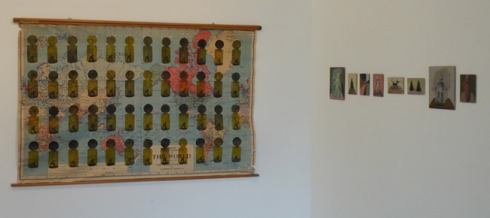
“MAP,” Etching ink on original ‘PHILIPS’ world map by Roger Morris [ r e m o ] (Taranaki)
A map hung in many New Zealand primary schools in the 50-70s printed by the British company, George Philip & Sons, showing the British Empire (in pink), other colonial powers & British shipping lines as they were in the late 1940s.
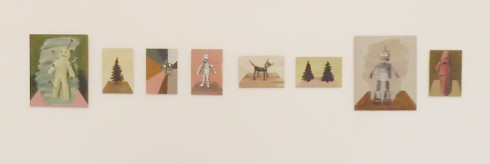
Acrylic on hardboard votive like paintings by Pietertje van Splunter.
Left to Right: Speldenpop (Pincushion doll), Een Boom (One Tree), Masker (mask), Bandenman (Tyre man), Kater (male cat), Twee Spanen (Two spruce), Blikken Man (Tin man), Langhoefd (Long head)
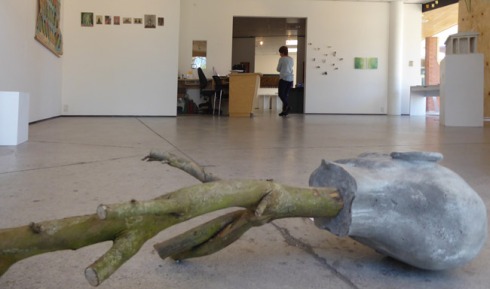
Far wall: Photographic emulsion on shells from Zeeland by Martje Zandboer (The Hague), Te Maharatanga | The Recollection, diptyph on dubond + “Tulips from Istanbul” (suspended cast resin orange tinted forms) by Sonja van Kerkhoff
Foreground, “Metamorphosis IV” by Sanne Maes.
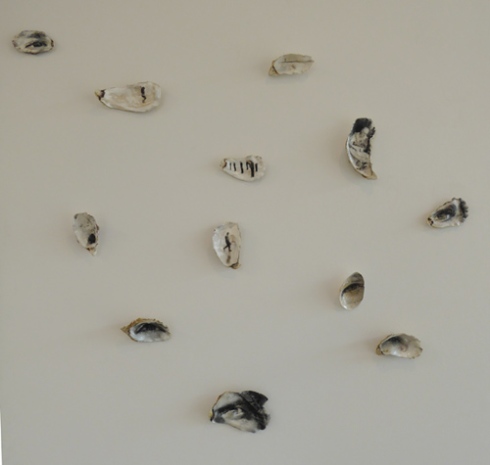
Photographic emulsion on shells from Zeeland by Martje Zandboer (The Hague)
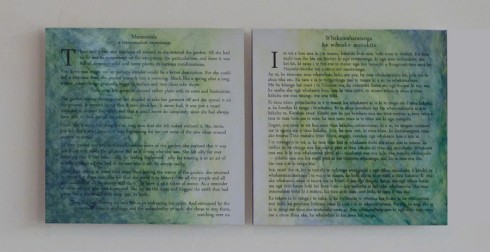
Te Maharatanga | The Recollection, oils on dubond, diptych by Sonja van Kerkhoff.
Each piece is 30 x 30 cm. Edition of 38.
The fairytale takes a feminine point of view where the garden is a gateway for transcending social conditioning. Translation: Te Toroa Pohatu (Ngāti Apa).
Met dank aan Stroom Den Haag / with thanks to STROOM The Hague for finanicial assistance as well as to NorthArt.
]]>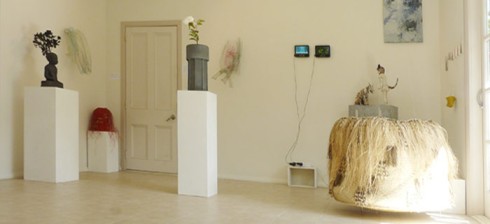
Left to Right: St Cyricus, plastic, artificial flowers and Epoxy, 40 x 15 x 60 cm by Brit Bunkley; Netting, wire and acrylic, by Michelle Backhouse; Pouhine (red basket form), harakeke (flax), muka (flax fibre), commercial dyes. Raranga + whatu (Māori weaving techniques) by Adrienne Spratt; Lake Alice Water-tower, plastic, paint and artificial flowers, 60 x 12 x 12 cm, by Brit Bunkley; Into the pink, wire and acrylic, by Michelle Backhouse; Cleaning the Air, 43 sec video + Daily Dishes, 7 min 11 sec video by Pietertje van Splunter; Oil on canvas by Edward Walton; From the War / No War series, six laser print on card reliefs (obliquely on the wall) by Hohepa; Kete Pingao, 20 x 10 cm, woven basket by Brenda Tuuta; Herenga rahi (Big connections/confinement), harakeke, muka, tanekaha bark and paru dyes. Raranga, whatu (Māori weaving techniques, suspended basket) by Adrienne Spratt.
Bunkley saw this statue in the Los Angeles Getty museum (view this statue) and was intrigued by the idea of a saint being a child. The story goes that in about 200-300 AD, that the child while being held by the governor (while the child’s mother, Saint Julitta, was on trial) the child stated that he was also a Christian and bit the governor. For this act of defiance the child was killed. Other stories tell of him being brutally tortured. The Renaissance artist incorporated symbols of sainthood such as the palm and laurel branches, and the cut off body suggests that he might be in a cauldron. The recasting of this in dark grey plastic with the addition of artificial flowers, makes the work an enigma because both aspects of social history (the religious and the art context of the statue at present) are simultaneously referenced and distanced.
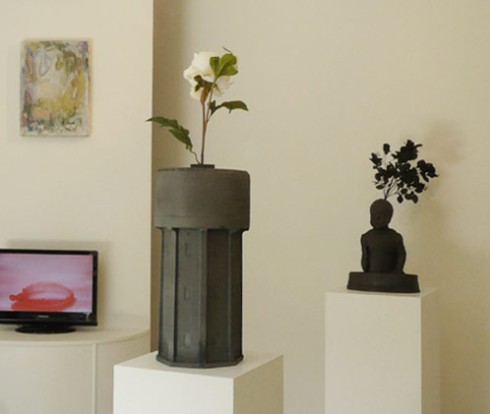
L to R: Een Rode Citroen (A red lemon), 2015, 9 min 53 sec., video + soundscape by Anne Wellmer; Oil on canvas by Edward Walton; Lake Alice Water-tower + St Cyricus by Brit Bunkley.
The flower could be a sign that nature always endures, always has some measure of self-sufficency, while the static cultural innate object gains or loses meaning if its function is lost. However in foregrounding the materiality of these sculptures, such as details in the greyer than grey facades, he reminds us that this is still artifice, it is still plastic, and in the end this is a sculpture of oppositions that forces us to take our own stance.
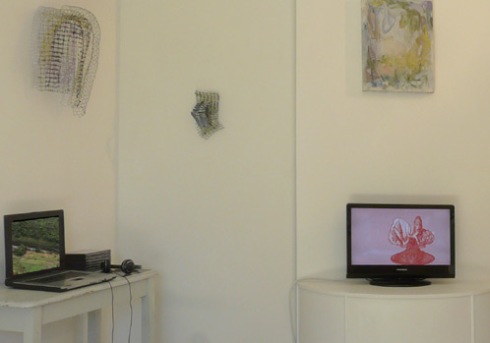
Left to Right: Kāinga a roto (Home Within), suite of 5 videos (on laptop) by Sonja van Kerkhoff, Adumbrate No. 2, 2014, wire netting + Untitled, 2017, wire netting and building paper by Michelle Backhouse; Oil on canvas by Edward Walton; Een Rode Citroen (A red lemon), 2015, animation, 9′ 53” by Anne Wellmer. Soundtrack: Anne Wellmer. Drawings: Geerten Ten Bosch. Animation: Harriët van Reek. Text excerpt from The Writing Notebooks (edited in English by Susan Sellers) by Hélène Cixous. Voice: Stephie Büttrich-Kolman.

Still from Vox Sanguinis (Voice of the blood), 1’53”. Video and soundtrack: Anne Wellmer. Video and soundtrack: Anne Wellmer. Camera: Florian Cramer. Voice: Cora Schmeiser. Music: “O rubor sanguinis” by Hildegard of Bingen. Trumpet: Heimo Wallner. Silent performer and stage design: Geerten Ten Bosch
Another video Vox Sanguinis (Voice of the blood), was a teaser for the music theater performance by Cora Schmeiser with new compositions inspired by Hildegard of Bingen (1098-1179) by 4 Dutch composers: Giuliano Bracci, Kate Moore, Lukas Simonis, Boudewijn Tarenskeen and Aliona Yurtsevich. The sound design and live electronics were by Anne Wellmer. Vox Sanguinis toured to four cities in the Netherlands in 2015.
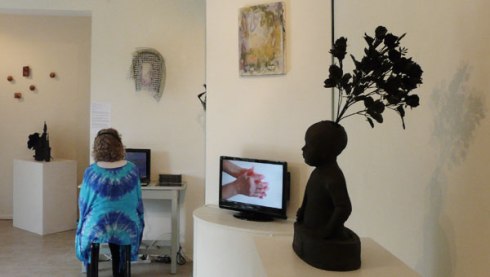
Left to Right: Warm Memories, emulsion on five suspended teabags by Martje Zandboer; The Happiest place on earth, plastic, paint and artifical flowers, 55 x 45 x 10 cm, by Brit Bunkley; Kāinga a roto (Home Within), videos (on laptop) by Sonja van Kerkhoff; Adumbrate No. 2, 2014, wire netting + Untitled, 2017, wire netting and building paper by Michelle Backhouse; Oil on canvas by Edward Walton; Transfusionen (Transfusions), 2015, video with sound, 2′ 43” by Anne Wellmer. Sound: Anne Wellmer. Hands: Geerten Ten Bosch. Voice: Cora Schmeiser. Music fragment from BLAST (2015) by Lukas Simonis. Text fragment from ‘Della Religione Christiana’ by Marsilio Ficino (1433-1499), first published in Italian in 1568. This German translation was published in ‘Das Blut: Symbolik und Magie’ (Blood: Symbolism and Magic) (2004) by Piero Camporesi; St Cyricus 3D plastic print sculpture by Brit Bunkley.
The sounds from these three videos were the soundscape of this show unless one put on headphones to listen to two of the other videos in the exhibition. Under two spatial abstractions of wire by Michelle Backhouse was the suite of videos, Kāinga a roto (Home Within), by Sonja van Kerkhoff (More >>) and around the corner was the 29 minute video, Et in Arcadia Ego by Channa Boon.

Left to Right: Et in Arcadia Ego, 29 min video by Channa Boon; Love of the other, 10 cm diameter, print on aluminium by Sonja van Kerkhoff; Muka and taniko kete, harakeke muka, tanekaha bark + paru dyes. Whatu and taniko (Māori fibre and weaving techniques) by Adrienne Spratt; What kind of Idea, print on dubond by Sonja van Kerkhoff (More >>).
Virgil’s phrase ‘Et in Arcadia Ego’ is also the title of a famous painting (1638) by Nicolas Poussin. The painting shows a group of shepherds who discover the phrase on a tomb, and so become aware of the existence of death in their Arcadian existence. This gives them the capacity to reflect and thus develop self-awareness. In this video, Boon connects this loss of innocence of the Arcadian shepherd – signifying an ideal world that is destroyed forever – with the present and past of the former Soviet Union. Hence, the phrase becomes a reference to the ideal world that Communism aimed to bring about in this region and the nostalgia that it still invokes.
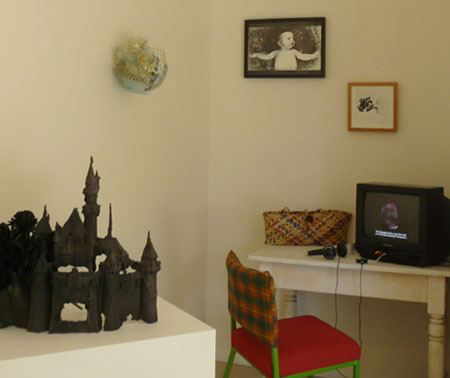
Left to Right: The Happiest place on earth, plastic, paint and artifical flowers by Brit Bunkley; Enclosure No. 1 wire netting + paperpulp by Michelle Backhouse; The Image (The spectacle is mesmeric in order to be successful), silkscreen print and mixed media (More >>) + Where change is barely visible, 2008, laser print by Sonja van Kerkhoff; Kete Whakairo (on table), dyed flax basket by Brenda Tuuta; Et in Arcadia Ego, 29 min video by Channa Boon.
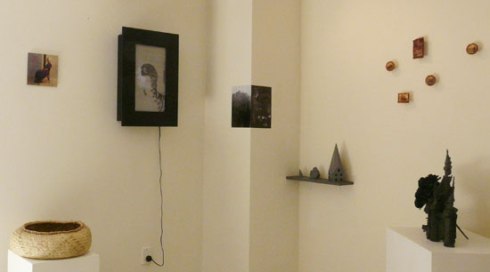
Left to Right: Mauri, harakeke, raranga (Māori weaving techniques) by Adrienne Spratt; Josephine’s Mother, print on aluminium, acrylic and varnish by Sonja van Kerkhoff (More >>); Bird of Prey, mixed media video loop by Sanne Maes; Untitled + Dark Entries, black and white photographs + The Speed of Dark, models on a shelf by Thom Vink; Warm Memories, photographic emulsion on teabags + magnets by Martje Zandboer and The Happiest place on earth, plastic, paint and artifical flowers, 55 x 45 x 10 cm, by Brit Bunkley (More >>).
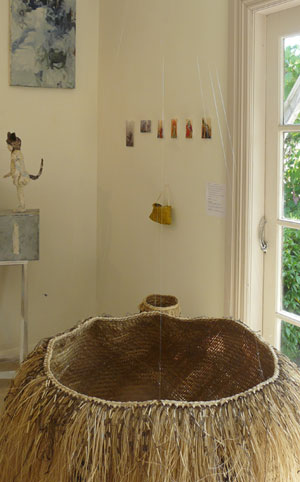
Left to Right: detail of Girl with Iberian Lynx by Michelle Backhouse; Oil on canvas by Edward Walton; From the War / No War series, six laser print on card reliefs, each is 10 x 15 x 2 cm, by Hohepa; Poutama (Step pattern), cylinder shaped basket + Herenga rahi (Big connections/confinement), harakeke, muka, tanekaha bark and paru dyes. Raranga, whatu (Māori weaving techniques) by Adrienne Spratt.
On the other side of the gallery space are two more woven vessels by Adrienne Spratt. The enormous basket sways from numerous lines. Its title refers to both connection and enclosure.
On the adjacent wall a frieze relief of reproductions of paintings from Hohepa’s War / No War series uses Maori cultural symbols as commentary issues of the day. Below this is a small purse-like open pingao (a New Zealand natuve yellow grass) basket by Brenda Tuuta.
In another corner lines flow out from the red basket, Pouhine by Adrienne Spratt, which blur its contours. The title refers to the pattern woven into the sides.
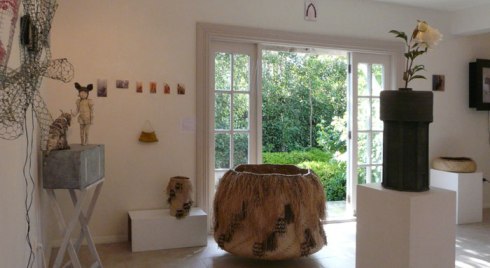
Left ot Right: Detail of Into the Pink, wire and paper pulp + Girl with Iberian Lynx by Michelle Backhouse; From the War / No War series, six laser print on card reliefs, each is 10 x 15 cm, by Hohepa; Kete Pingao, 20 x 10 cm, woven basket by Brenda Tuuta; Poutama (Step pattern), cylinder shaped basket + Herenga rahi (Big connections/confinement), harakeke, muka, tanekaha bark and paru dyes. Raranga, whatu (Māori weaving techniques) by Adrienne Spratt, Paewae (Threshold), aluminium print (above doorway) by Sonja van Kerkhoff; Lake Alice Water-tower, plastic sculpture by Brit Bunkley; Josephine’s Mother, print on aluminium, acrylic and varnish by Sonja van Kerkhoff; Mauri (essence/spirit), harakeke, raranga (Māori weaving techniques) by Adrienne Spratt; Detail of Bird of Prey, mixed media video loop by Sanne Maes.
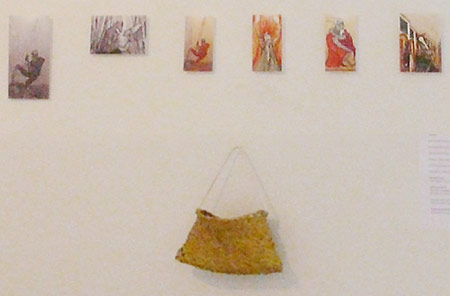
Left to Right: From the War / No War series: Warrior with Taiaha, Patu-paiarehe lovers, black and white laser prints on card, Warrior with Taiaha, Mākutu, No more war with Taiaha laid down, Rangatahi, colour laser prints on card, each piece approx. 10 x 15 x 2 cm, by Hohepa; Kete Pingao, 20 x 10 cm, woven basket by Brenda Tuuta.
The video Cleaning the Air is actually a recording of a mobile sculpture which animates various household cleaning objects while in the video, Daily Dishes, the mundane chore of doing the dishes is turned into an animation of colour and pattern. Pietertje van Splunter’s videos are like a poetics on the mundane: housework. Her brooms seem animated by an unearthly force and the constant stacking of the differing tribes of kitchen utensils suggests a game with secret rules. In using humour with the overkill her videos are reminders that the everyday domestic, is also a microcosm of the amusing, perhaps necessary banality of habit while Michelle Backhouse’s sculptures use seemingly banal materials, building paper, netting or house paint to create ethereal protusions.]]>
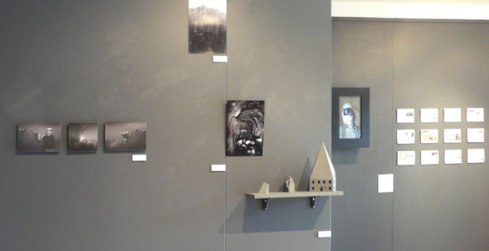
Detail of “The Poetic Condition” in the Shutter Room, Whangarei.
Left to Right: Triptych by Inge Reisberman, Photos and model by Thom Vink, Video-drawing by Sannes Maes and the grid of photo-drawing combinations by Christiaan van Tol.
Tomorrow is the final day of the show and this ends with a spectacular presentation beginning at 12 noon by Auckland artist, Raewyn Turner, who will show and demonstrate inter-sensory correspondences in her own art projects as well as leading a discussion on ‘the poetic condition’ when it comes to the artistic practice. Links to a 7 min film about her scent work and where and when, and the Facebook event page.
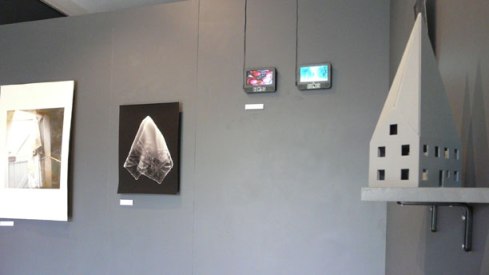
Left to Right: Photograph + mixed media by Marg Morrow, Photogram by Megan Dickinson, Videos by Pietertje van Splunter, detail of a photo-model installation by Thom Vink

Left to Right: Detail of photos and model by Thom Vink, Two photo-grams by Lisa Clunie, Photograph by Elektra Bakhshov.
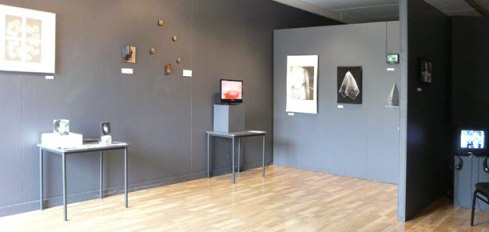
Left to Right: Photograph by Ellie Smith, Print by Sonja van Kerkhoff, Video by Anne Wellme (in collaboration with Geerten Ten Bosch, Harriët van Reek + Stephie Büttrich-Kolman), Photograph + mixed media by Marg Morrow, Photogram by Megan Dickinson, Videos by Pietertje van Splunter, detail of a photo-model installation by Thom Vink, Video by Channa Boon.
“Disarm (mechanized)” by Pedro Reys are a collection of mechanical musical instruments made in part out of firearms, including revolvers, shot-guns and machine-guns, given to him by the Mexican government in the city of Ciudad, Juarez, after they had been rendered useless by tanks and steamrollers. In hearing of his work “Palas Por Pistolas,” where he transformed 1,527 guns owned by the residents of Culiacán by melting these down into 1,527 shovels, which were then used to plant 1,527 trees around the world, he was offered 6,700 destroyed weapons from the Mexican Secretary of Defence in 2012. “Disarm (Mechanized),” his second work made from these firearms, can either be automated or played live by an operator using a laptop computer or midi keyboard. This 3.55 min video clip is a piece run from a laptop titled “Turner 2015” in the Pulchri gallery in the Hague.
“For Pedro Reyes the process of transforming weapons into objects of positive utility was more than physical. “It’s important to consider that many lives were taken with these weapons; as if a sort of exorcism was taking place, the music expelled the demons they held, as well as being a requiem for the lives lost.” Artlyst.com, 25 Sept, 2015
“Pedro Reyes’ work is a socio-political critique on contemporary society and our responsibility towards it. His projects are catalysts for communal and psychological transformation, triggering group interaction and creativity.
Disarm is a demand for towns and cities across the world to relinquish their weapons and transform them from agents of death to agents of life. It is an attempt to highlight the invisible violence that underpins the international industry of death and suffering: the commercial and government complicity that allows for weapons to be made and sold by public companies for shareholder profit; the laws banning assault rifles which go neglected; and the films and video-games which depict trigger-happy heroes. For Reyes, an idealist whose projects affect real change and are often explicit attempts to improve the society around him, a world free of guns is a human right, and a utopian ideal to which we should all aspire.” Lisson Gallery, 2013, London.
Pedro Reyes was born in Mexico City in 1972, where he lives and works. He has won international attention for his large-scale projects that associate social issues with imaginative solutions. Pedro Reyes was awarded a Medal for the Arts in January 2015, by the US State Department for his continued commitment to the State Department’s cultural diplomacy outreach.
See his website or his blog for more.
TodaysArt Festival, hosted annually since 2005 in the Hague, focusses on the presentation and development of contemporary visual and performing arts and emerging culture. About the 2016 edition.
]]>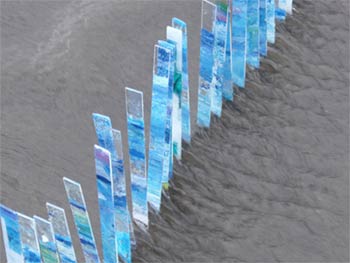
Waitapu (sacred water) Wairere (flowing water) by Vallance Wrathall, New Zealand, for the first session for the 2016 Water Works online symposium curated by Ian Clothier which will air, New Zealand time, on March 19th at 4pm. Tune in here: water-wheel.net/taps-list
“The placement of this installation at Ngamotu beach, New Plymouth, was in relation to the historical significance this water source had with the people of this area, extending as far back as the 1600s through to today. Water has a story to tell, we as people need to take our time to listen.” Vallance Wrathall, 2016.
This will be your last chance to tune into to watch the annual water themed presentations and performances using the Waterwheel interactive, collaborative platform from March 19 onwards http://water-wheel.net/taps-list (This link shows you the time and date in your local time for the 7 sessions spread over 34 hours. You only need to log in if you wish to comment.) Run marathon-style, each 2 hour session will be broadcast from a different part of the world.
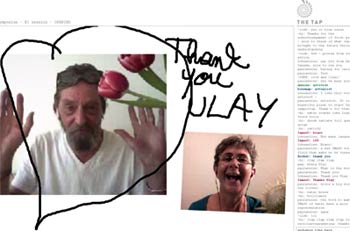
Screen capture during ‘100 Names for Water’ talk by Ulay during the opening of the “Water Views: Caring and Daring – Waterwheel World Water Day Symposium 2014.” The images of Ulay (in Slovenia) and Suzon Fuks (in Brisbane) show the live video feed in a ‘stage’ panel where you can add up to 6 ‘video windows’ as well as text, slideshows or drawings. The live text chat is on the right. You can watch this talk here: water-wheel.net/media_items/view/4851
Some of these presentations are later published, and in 2014 an e-book was published which you can view here >> blog.water-wheel.net/2015/02/e-book-water-views-3WDS14.html
Here 450 participants, from 34 countries across 5 continents, interacted with audiences in real time on the internet and in 18 physical venues or ‘nodes,’ using the Waterwheel online video and sound platform. The symposium, held 17-23 March 2014, also focussed on a youth & inter-generational dialogue “Voice of the Future” strand.
Waterwheel was co-founded in August 2011 by Brisbane-based artist, Suzon Fuks, the design studio Inkahoots, who developed this, and the arts organisation Igneous, which manages it. It has never had any paid staff and the resources for its development from Australian national and Queensland state government arts funding were for artists who did projects using the platform. So now after 5 years the 2016 annual water themed online conference will be the last.
So to wet your appetite for this year’s theme Water Works – where 22 curators from 19 countries will discuss selected entries and respond to an online audience in a streaming event on Waterwheel.
The programme overview is here: http://bit.ly/WATERworks-programme
Indian classical singer Mahesha Vinayakram will open and close “Water Works” with a performance.
The first two hour session (water-wheel.net/taps/view/854) will be presentations of videos selected by San Franscico-based artist and teacher, Michele Guieu (micheleguieu.com/wordpress) followed by a presentation of seven New Zealand artists, curated by Ian Clothier (ianclothier.com) who runs the biannual media art residency and symposium SCANZ(www.intercreate.org) in New Plymouth where he lives.
The next session (water-wheel.net/taps/view/855), starting 2 hours later, is curated by Katarina Djordjevic Urosevic ((artskylight.com), Serbia), Joanna Hoffmann (University of Arts, Studio for Transdisciplinary Projects and Research, Poznan, Poland) and artist Pascale Barret (pascalebarret.com), Belgium)
Water Works session #3 (water-wheel.net/taps/view/856) is curated by:
West D.L. Marrin, an applied scientist in biogeochemistry, pollutant dynamics, water resources, and aquatic ecology. His lectures focus on global water quality threats, hydromimicry practices, and the water-energy-food nexus. He is a former adjunct professor at San Diego State University, U.S.A.;
Claudia Jacques & Victoria Vesna (waterbodies.org). Claudia (claudiajacques.com), currently a PhD candidate at the Planetary Collegium, CAiiA Hub, University of Plymouth, UK., researches space-time aesthetics in the user-information-interface relationship through the lens of Cybersemiotics. Intersecting art, technology and science, she designs interactive hybrid art and information environments that aim to explore perceptions of space-time and the digital-physical in the pursuit of human consciousness. Victoria (victoriavesna.com) is an artist and Professor at the UCLA Department of Design | Media Arts and Director of the Art|Sci center at the School of the Arts and California Nanosystems Institute (CNSI))
and Lila Moore (mdx.academia.edu/LilaMoore), an artist film-maker, screen choreographer, networked performance practitioner, and theorist based in Israel. She is a post-doctoral researcher at The I-Node of the Planetary Collegium, Plymouth University, UK, and holds a doctorate from Middlesex University in Dance on Screen which explores choreography for the camera and screen-dance in the contexts of performative and hybrid art forms, with special reference to ritual and myth from a feminine/feminist perspective.
Water Works session #4 (water-wheel.net/taps/view/857) is on sound art works and is curated by Leah Barclay, Eric Leonardson and Ricardo Dal Farra.
Leah Barclay (leahbarclay.com) is an Australian interdisciplinary artist, composer and researcher who specialises in electroacoustic music, sound art and acoustic ecology. Leah has received critical acclaim for her immersive performances, installations and large-scale community projects that explore volatile environments ranging from the central Amazon Rainforest to the floor of the Australian ocean. Her work is multi-platform in nature and often involves long-term community engagement accompanied by the development of virtual platforms to explore the value of digital technology in environmental crisis. Her diverse creative practice has resulted in a dynamic freelance career where she works as an artist, consultant, educator and researcher with various organisations and institutions. These include designing immersive education programs for UNESCO, directing large-scale interdisciplinary research projects for major universities across Australia and the USA and facilitating partnerships between communities, NGOs and government to explore creative approaches to climate action.
Eric Leonardson (ericleonardson.org) is a Chicago-based composer, radio artist, sound designer, instrument inventor, improviser, visual artist, and teacher. He has devoted a majority of his professional career to unorthodox approaches to sound and its instrumentation with a broad understanding of texture, atmosphere and micro-tones.
And Ricardo Dal Farra (linkedin.com/in/ricardodalfarra) is an Argentine composer and multimedia artist, researcher, educator, performer and curator focusing mainly on new media arts and electroacoustic music for more than 25 years. Dal Farra holds a PhD in Etude et pratiques des arts from Université du Québec à Montréal and is Founding Director of Centro de Experimentación e Investigación en Artes Electrónicas – CEIArtE (Electronic Arts Experimenting and Research Centre) at National University of Tres de Febrero, Argentina; Associated Researcher at the Music, Technology and Innovation Research Centre, De Montfort Univerisity, United Kingdom; and Senior Consultant for the Amauta – Andean Media Arts Centre in Cusco, Peru.
Water Works session #5 (water-wheel.net/taps/view/858) is curated by:
Eklavya Prasad (linkedin.com) a social development professional who has led a grassroots campaign in rural north Bihar, New Dehli, India, since 2005 on decentralized and alternative drinking water solutions;
Atefeh Khas (atefehkhas.com) an Iranian artist who specializes in environmental installations, and is a member of the environmental artists group “Open Five” since 2005,
and Catherine Lee + Margaret Shiu, directors of the Bamboo Curtain artist residency studio (bambooculture.com), in Taipei, Taiwan.
Water Works session #6 (water-wheel.net/taps/view/859) is curated by:
Tracey Benson (canberra.academia.edu/TraceyBenson) a media artist and academic based in Canberra, Australia;
Amin Hammami (linkedin.com) previously a lecturer in Cinema, Audiovisual and Sound Art at the Higher Institute of Multimedia Arts of Manouba in Tunisia and now at the University of Dammam in Saudi Arabia. He has been involved with Waterwheel since 2011.
Tracey Benson (canberra.academia.edu/TraceyBenson), and
Amin Hammami (linkedin.com) previously a lecturer in Cinema, Audiovisual and Sound Art at the Higher Institute of Multimedia Arts of Manouba in Tunisia and now at the University of Dammam in Saudi Arabia. He has been involved with Waterwheel since 2011, and
Camilla Boemio (camillaboemio.com), an Italian curator focussing on socio-political developments within contemporary society. She was Deputy Curator of the Maldives Pavilion at the 55th Venice Biennale and was consultant for the art-science section at ISWA European project (Immersion in the Science Worlds through Arts).
A workshop on audio recording and streaming
(water-wheel.net/taps/view/860) by the London arts collective, Soundcamp (soundtent.org). Technologies for setting up a temporary or long-term live audio stream using a mobile phone or a laptop as well as a dedicated streambox out of low cost components, using the Raspberry Pi micro processor and Primo microphone capsules to make up cheap, high quality stereo microphones, will be demonstrated.
Real time audio has the potential to create a compelling connection to a site, which can directly convey much of the feel and uniqueness of a location. A small but significant group of projects is establishing a network of streams from diverse soundscapes around the world. Some of these events are SoundCamp 2016, (30 April – 1 May 2016), a 24 hour live stream of audio radio around the globe for International Dawn chorus Day (idcd.info) on May 1st, the Locus Sonus open microphone network (locusonus.org), the Balance Unbalance conference on acoustics and ecology in Colombia (9-11 May 2016), and World Listening Day 2016 (18 July 2016).
Water Works session #7 (water-wheel.net/taps/view/861) is curated by:
Annie Abrahams (bram.org) based in France, she is an pioneer of networked performance art.
Russell Milledge (researchgate.net) a co-founder of the interdisciplinary artists’ collective Bonemap (bonemap.com) which is concerned with the ecological edges of civilisation while creating immersive art and performance based in far northern Australia. Projects often engage Cape York, Torres Strait Islander and international contemporary artists.
Jason Grant (Australia)
And the waterwheel blog is an archive of water related events: http://blog.water-wheel.net
]]>




